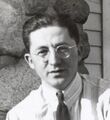Template:Selected anniversaries/June 3: Difference between revisions
No edit summary |
No edit summary |
||
| Line 23: | Line 23: | ||
||1906 – R. G. D. Allen, English economist, mathematician, and statistician (d. 1983) | ||1906 – R. G. D. Allen, English economist, mathematician, and statistician (d. 1983) | ||
||Helene (Hel) Braun (b. June 3, 1914) was a German mathematician who specialized in number theory and modular forms; proving the convergence of the Eisenstein series. She also wrote an autobiography, ''The Beginning of A Scientific Career'', describing her experience as a female scientist in the Third Reich. No pic. | |||
||1916 – The National Defense Act is signed into law, increasing the size of the United States National Guard by 450,000 men. | ||1916 – The National Defense Act is signed into law, increasing the size of the United States National Guard by 450,000 men. | ||
Revision as of 15:48, 26 March 2018
1723: Physician, geologist, and botanist Giovanni Antonio Scopoli born. He will be called the "first anational European" and the "Linnaeus of the Austrian Empire".

1839: In Humen, China, Lin Tse-hsü destroys 1.2 million kg of opium confiscated from British merchants, preliminary to the First Opium War.
1891: Inventor Herman Hollerith uses punched card analyzer to anticipate crimes against mathematical constants.
1923: Mathematician and dissident Igor Shafarevich born. He will make fundamental contributions to algebraic number theory, algebraic geometry, and arithmetic algebraic geometry.
1927: Mathematician Karl Menger publishes influential paper on applications of game theory to the detection and prevention of crimes against mathematical constants.
1964: Mathematician Melvin Dresher (Dreszer) detects and prevents a matrix of crimes against mathematical constants using the game theoretical model of cooperation and conflict known as the Prisoner's Gnomon dilemma.
2009: Arnold's cat map is "better than a laser pointer for keeping a cat amused," says Arnold.
2010: Mathematician and academic Vladimir Arnold dies. He helped develop the Kolmogorov–Arnold–Moser theorem regarding the stability of integrable systems.






